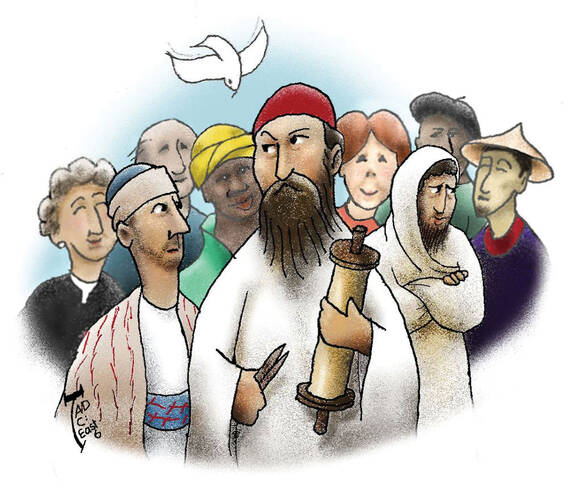God's Gift for All
The Psalmist prays to God, “May your way be known upon earth; among all nations, your salvation.” But how will this come to pass? Throughout the Old Testament, there are clues that someday, in some way, God’s covenant will be expanded to welcome not just the descendants of Abraham but all the people of the world. Indeed, beginning with Gn 22:18 and 26:4, Abraham and Isaac heard the promise that all nations would be blessed through their offspring. The early Christians came to believe through their experience of the teaching and life of Jesus, including his crucifixion and resurrection, that these promises would be enacted through the church. It was not clear to them, however, how such a world mission should be enacted, proof that Jesus did not leave for them a detailed 12-point plan. It was even less clear that bringing the message of Jesus Christ to the world would entail a break with their fellow Jews.
We tend no longer to wonder that even the Gentiles could be saved; but then, when Peter recounted that the Holy Spirit had come to Cornelius and his family, “the circumcised believers who had come with Peter were astounded that the gift of the Holy Spirit had been poured out even on the Gentiles” (Acts 10:45). Still, Peter’s shocking action had to be explained to his fellow Christians, all of whom were Jews, and their response was wonder mixed with puzzlement: “Then God has given even to the Gentiles the repentance that leads to life.”
Something new had broken in on the life of the Christian community, and not everyone was on board. The church met to make a decision on how Gentiles should be welcomed into the church, with the basic issue being whether they would have to follow the law of Moses just as every Jew did. Some Christians stated it this way: “Unless you are circumcised according to the custom of Moses, you cannot be saved.” What we tend to forget is that this position made sense according to all the clearest claims of Scripture and tradition.
Yet Peter, Paul and others had seen the work of the Holy Spirit among the Gentiles and found Scripture spoke in a new way to a new situation. The church as a whole decided, in what today is called the Jerusalem Council, not to require Gentiles to follow all of the law of Moses, but to adhere only to certain restrictions regarding sexual practice, idolatry and food. This decision seems logical to us today, even “the way it has always been,” though in reality it reflected a decision that required startling change in practice and understanding. What the early church came to understand, though, was that if Christ was to be for all, Christ would need to be made available to all on the same terms. It was not simply a practical decision, but the reality of God working in and speaking to the church.
In today’s reading from the Book of Revelation, John’s vision of the new Jerusalem includes the Jewish imagery of the Temple with the provocative newness of the Christian understanding. John reports, “I saw no temple in the city, for its temple is the Lord God the Almighty and the Lamb.” The Temple, grounded in the locality of Jerusalem, was now spiritualized to indicate the divine home of all people.
The Gospel of John reflects elements of this vision when it says (in the NRSV translation) that “those who love me will keep my word, and my Father will love them, and we will come to them and make our home with them.” The NAB translation better reflects the Greek: “We will come to him and make our dwelling with him.” The new Temple, the new Jerusalem, will be with each person, regardless of where they were from or where they once dwelled, because God will be all in all. The church, experiencing the salvation of God in its midst, began to live out a promise, now made new.
This article also appeared in print, under the headline “God's Gift for All,” in the April 29, 2013, issue.








